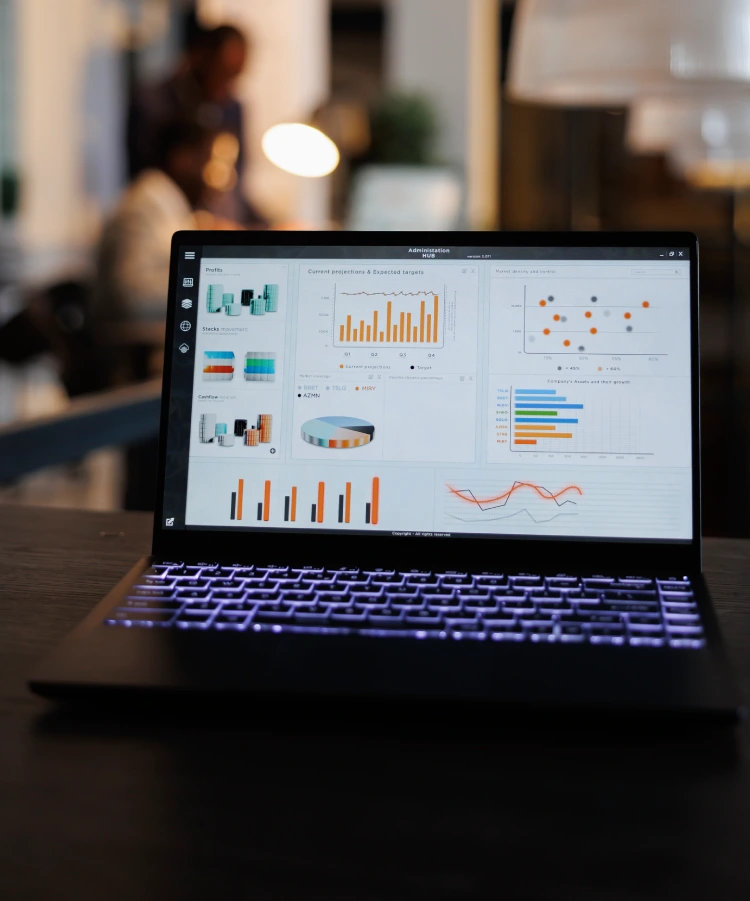Predictive Lead Scoring Combined with AI is a Game Changer for Your Sales Funnel
Are your sales and marketing teams struggling to sift through tons of leads, unsure where to focus their efforts? If so, you’re not alone. The pressure to improve KPIs and close more deals is more intense than ever, especially with shrinking budgets. Enter predictive lead scoring combined with AI—a pivotal tool that’s transforming sales funnels across industries.
By automatically analyzing vast datasets—from CRM entries to social interactions—AI-driven lead scoring pinpoints the most promising leads, elevating your team’s efficiency and accuracy. This tech duo helps prioritize efforts, predict customer behaviors, and streamline the sales process, tackling one of today’s biggest business challenges head-on. When used together, you can unlock higher conversion rates and create more efficient sales cycles. In this article, we’ll explore how this game-changing innovation can supercharge your sales funnel.
Understanding Conversion Rate
Boosting your conversion rate can significantly impact your business, often more than just increasing the number of leads. To see why this matters, it’s essential to understand what a conversion rate is.
At its core, your conversion rate is the percentage of visitors who complete a specific goal. But there’s more to it. You should know when and why leads drop off and work on maximizing the number of quality leads that convert.
Imagine your website has a 2.3% conversion rate with an average of 250 new visitors a day, or 7,500 visitors a month. This gives you about 5 conversions per day. To reach 1,000 sign-ups in a month, you would need 43,478 visitors. However, if your conversion rate improves to 11%, you’d only need 9,000 visitors to achieve the same goal.
This means your company can hit high revenue targets even with fewer visitors. Top-performing sites with a 25% conversion rate would only need 4,000 visitors to reach their goals, rather than over 40,000.
There are many strategies to boost your conversion rate, such as predictive lead scoring combined with AI.
Unlock Insights: Sign Up for Our Blog
Understanding Predictive Lead Scoring
Predictive lead scoring combined with AI is changing the way businesses approach their sales processes. By utilizing advanced data analytics and AI, companies can now identify their most promising leads with pinpoint accuracy. This makes it easier for sales teams to focus their efforts where it matters most, ultimately accelerating the sales funnel.
The Evolution of Lead Scoring
Lead scoring has come a long way from its early days. Initially, sales teams had to manually sift through each lead, assigning scores based on a limited set of criteria. This process was time-consuming and often inaccurate, relying heavily on human intuition and guesswork.
The introduction of automated systems marked a significant shift. With the help of Customer Relationship Management (CRM) software, businesses could now automate data collection and basic scoring tasks. Things improved, but these systems still lacked the ability to make nuanced distinctions between leads. For the most part, they couldn’t accurately tell a casual website visitor from a potential customer ready to purchase.
Enter AI-powered predictive lead scoring. This modern approach integrates machine learning to analyze huge datasets from varied sources like CRM entries, website behavior, social media, and Internet of Things (IoT) data. This enables the system to identify patterns and predict lead conversion potential with unprecedented accuracy.
For more information about how traditional approaches have evolved, HubSpot has a great overview of lead scoring’s history and predictive capabilities.
How Predictive Lead Scoring Works
Predictive lead scoring is like having a supercharged crystal ball for your sales funnel. But how does it actually work? It starts with data—lots of it. The system pulls information from various sources, including:
- CRM Data: Information stored within your customer relationship management system, such as past interactions and lifecycle stages.
- Behavior Data: Actions taken by leads on your website, like page visits, downloads, form fills, and clicks.
- Social Data: Social media activities and engagements.
- IoT Data: Information from interconnected devices that can provide insights into customer behavior.
By leveraging advanced machine learning algorithms, the system analyzes these data points to find correlations between past behaviors and future conversions. Essentially, it asks, “What do leads that turned into customers have in common?” Once patterns are identified, the AI creates a predictive scoring model.
This model is continuously tested and refined, allowing it to update lead scores in real-time. This eliminates guesswork and ensures your sales team always has the latest insights at their fingertips.
To understand the nuts and bolts of setting up such systems, check out this comprehensive guide from Microsoft on configuring predictive lead scoring.
Incorporating predictive lead scoring into your sales funnel enhances your ability to target high-potential leads, thus dramatically increasing your chances of conversions and boosting your ROI.
For additional reading on the practical applications and benefits, Salesforce and HubSpot offer deeper insights and examples from real-world scenarios.
The Role of AI in Enhancing Lead Scoring
Artificial Intelligence (AI) has revolutionized many aspects of business operations, and lead scoring is no exception. With shrinking budgets and increased pressure to deliver results, sales and marketing teams are turning to AI-driven tools to improve efficiency and accuracy. By leveraging vast datasets, AI enhances lead scoring, enabling teams to prioritize efforts and target the most promising leads effectively.
Benefits of AI-Driven Lead Scoring
AI-driven lead scoring offers several key advantages that make it an invaluable tool for sales and marketing teams. Here are some of the most significant benefits:
- Better Lead Prioritization: AI algorithms can analyze large amounts of data to identify patterns and traits that indicate a lead’s likelihood to convert. This enables sales and marketing teams to focus on leads with the highest potential, improving conversion rates. According to ProPair, AI-driven lead-scoring models provide unparalleled precision in prioritizing and engaging potential customers.
- Time Savings: Manual lead scoring is time-consuming and often inaccurate – and pretty much obsolete. AI automates the process, allowing teams to allocate their time to more strategic activities. AI’s ability to swiftly process and analyze data ensures that lead scores are updated in real time, eliminating the need for constant manual updates. For further reading, MadKudu highlights how AI can streamline the lead scoring process.
- Higher Conversion Rates: By focusing efforts on the most promising leads, businesses can significantly improve their conversion rates. AI models are continually learning and adapting, which means they get better at predicting which leads are likely to convert. Salesforce explains how AI-driven lead scoring can take conversions to the next level.
- Enhanced Accuracy: Traditional lead scoring often suffers from human error and bias. AI eliminates these issues by relying on data-driven insights. This results in more accurate lead scoring, ensuring that no promising lead falls through the cracks. Momencio discusses the increased accuracy provided by AI algorithms.
Real-World Applications
Many companies have successfully implemented AI-driven lead scoring to enhance their sales funnels. Here are some examples of how AI is being used in the real world:
- Salesforce Einstein Lead Scoring: Salesforce’s Einstein Lead Scoring is a prime example of AI-driven lead scoring in action. By analyzing data from a variety of sources, Einstein provides sales teams with insights into which leads are most likely to convert. This tool has been instrumental in helping companies like CloudKettle improve their lead conversion rates.
- ProPair: ProPair uses AI to enhance its lead-scoring processes by analyzing historical data and behavioral patterns. This allows sales teams to prioritize leads more effectively, ultimately driving higher conversion rates.
- HubSpot: HubSpot’s AI-driven lead scoring capabilities have also been widely adopted by businesses looking to improve their sales funnel efficiency. The platform uses machine learning to analyze lead data and assign scores based on the likelihood of conversion.
By integrating AI into lead scoring, companies can unlock higher conversion rates and more efficient sales processes. These real-world applications demonstrate the transformative potential of AI-driven lead scoring and its ability to enhance sales funnel performance.
For more insights on AI and lead scoring, check out this detailed guide from MadKudu.
Implementing Predictive Lead Scoring in Your Sales Funnel
Implementing predictive lead scoring in your sales funnel can significantly enhance your team’s efficiency and conversion rates. By utilizing AI-powered tools, businesses can automatically analyze and prioritize leads, focusing on those with the highest potential. Below are key steps to help you implement predictive lead scoring seamlessly into your sales process.
Choosing the Right Tools
When it comes to selecting the right predictive lead-scoring tools and platforms, there are a few essential factors to consider. Picking the right tool can make all the difference in leveraging the full potential of predictive lead scoring.
- Data Compatibility: Ensure the tool can integrate with your existing data sources like CRM, social media, and website analytics. It should be capable of pulling and analyzing data from these various sources to provide accurate lead scores.
- Ease of Use: The platform should be user-friendly and require minimal technical expertise. A steep learning curve can slow down adoption and effectiveness.
- Cost: Evaluate the cost-effectiveness of the solution. While some platforms may offer comprehensive features, they might be too expensive. Look for tools that provide a balance between features and cost.
Integrating with Existing Systems
Successful implementation of predictive lead scoring depends on how well it integrates with your current systems. Seamless integration is essential to ensure data flows smoothly and that all teams can access the insights they need.
- CRM Integration: Your predictive lead scoring tool must integrate seamlessly with your CRM system. This ensures that lead scores are automatically updated and accessible to all team members. For instance, Microsoft Dynamics 365 offers detailed steps on configuring predictive lead scoring within its ecosystem.
- Marketing Automation Systems: Integration with marketing automation tools helps in syncing leads’ behavior data, enhancing the accuracy of the lead scoring model. This integration enables a holistic view of prospect behavior across various touchpoints.
- Data Syncing: Ensure that the integration allows for real-time data syncing. Delays in updating lead scores can result in missed opportunities and inefficiencies.
For additional tips on integrating predictive lead scoring tools, check out this article on lead scoring integration.
Training Your Team
Once you have selected and integrated the right tools, the next step is to train your sales and marketing teams on how to effectively use predictive lead scoring. Proper training ensures that your team can leverage the technology to its fullest potential.
- Hands-On Training: Conduct hands-on training sessions where team members can familiarize themselves with the new tools. Practical exercises will help them understand how to interpret and act on lead scores.
- Documentation and Resources: Provide comprehensive documentation and resources such as video tutorials and user manuals. This can serve as a reference for team members as they get accustomed to the new system.
- Ongoing Support: Offer ongoing support through regular team meetings and Q&A sessions. Having a support system in place ensures that any issues or questions can be promptly addressed.
- Performance Monitoring: Implement performance monitoring to assess how well team members are adopting the new tools. Encourage regular feedback sessions to help refine the training process and address any gaps.
By thoughtfully choosing the right tools, ensuring seamless integration with existing systems, and providing thorough training, your sales and marketing teams can effectively implement predictive lead scoring, driving higher conversion rates and more efficient sales processes.
Maximizing the Impact of AI in Your Sales Funnel
Using AI in your sales funnel can transform how you handle leads, enhance effectiveness, and drive higher conversion rates. AI-powered tools help you make data-driven decisions, optimize processes, and improve outcomes.
Continuous Improvement and Monitoring
Regularly updating and refining your AI models is crucial to ensure optimal performance. AI systems, like any other technology, require continuous improvement to stay effective. Here’s why it’s essential:
- Feedback Loops: Feedback loops are vital for AI improvement. By routinely feeding your model new data and results, it becomes smarter and more accurate over time. For instance, if a particular lead scored high but did not convert, this can be used to fine-tune the model.
- Performance Monitoring: Monitoring the performance of AI models helps identify areas that need refinement. Regularly review metrics such as lead conversion rates, sales cycle length, and customer acquisition cost. These insights will highlight the AI model’s strengths and weaknesses, allowing for targeted adjustments.
- Dynamic Market Conditions: The market is always evolving. Consumer behavior, economic conditions, and competitive landscapes change frequently. Regular updates ensure that your AI model adapts to these changes, maintaining high predictive accuracy.
For more detailed strategies on leveraging AI, check out this article from SalesMind AI.

Image by ThisIsEngineering
Future Trends
The future of AI in sales funnels is bright, filled with innovative technologies and methodologies that promise to further enhance the effectiveness of lead scoring.
Here are some emerging trends to watch:
Generative AI: Generative AI isn’t just a buzzword. Tools like ChatGPT are being used to create personalized, dynamic content, from follow-up emails to detailed product recommendations. This not only saves time, it also ensures a more personal touch in your sales communications.
Predictive Analytics: Moving beyond basic lead scoring, predictive analytics incorporates more sophisticated algorithms to forecast future behaviors and trends. This can help in anticipating market shifts and adjusting strategies proactively.
Unified Data Platforms: There’s a growing trend towards integrating all marketing and sales data into a single platform. This unification allows for more accurate and holistic insights, enhancing the effectiveness of AI models.
Enhanced Personalization: AI is becoming more adept at personalization, using detailed data to tailor interactions to individual leads. This could mean personalized sales pitches, bespoke product recommendations, or customized follow-ups, significantly boosting engagement and conversion rates.
The eWeek article on using AI for lead generation delves into strategies and tools that leverage AI to create more meaningful and effective sales processes.
By staying updated with these trends and continuously improving your AI models, you can maximize the impact of AI in your sales funnel, ensuring more efficient operations and higher conversion rates.
For more on AI’s role in sales strategy, the Center for Sales Strategy provides a comprehensive overview of leveraging predictive analytics and AI in sales.
Conclusion
Predictive lead scoring combined with AI truly transforms your sales funnel. This technology empowers your sales and marketing teams to prioritize efforts more effectively, focusing on leads that are most likely to convert. By analyzing extensive data from CRM entries, web behaviors, and social interactions, AI-driven lead scoring provides pinpoint accuracy and eliminates guesswork.
Incorporating predictive lead scoring into your sales strategy not only boosts conversion rates, it optimizes your resource allocation, ensuring that every effort drives maximum impact. Stay competitive by adopting this innovative approach, and watch your sales funnel become more efficient and productive.


